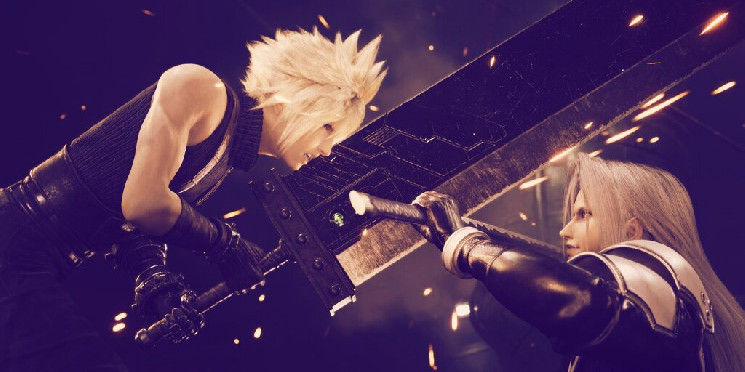Final Fantasy NFTs Coming to Polkadot in Square Enix, Enjin Alliance

One of the most successful video game series of all time is set to receive the NFT treatment in 2023, as Japanese publisher Square Enix has partnered with blockchain gaming firm Enjin to release NFTs based on the Final Fantasy franchise.
The NFTs won’t be purely digital products, however. They’re tied to physical action figures and trading cards based on the smash role-playing game (RPG) Final Fantasy VII to commemorate the original PlayStation game’s 25th anniversary.
Square Enix will first release packs of physical trading cards in spring 2023 that will sell for $4 per six-card pack. Each comes with a code to redeem for a single NFT trading card minted by Enjin on its Efinity platform, which is built on the Polkadot blockchain.
In November 2023, the publisher will release a limited edition action figure of the game’s star, Cloud Strife. Both the standard figure and “Digital Plus Edition” will come with a code to redeem an NFT certificate of authenticity, but only the latter comes with an additional NFT: a digital replica of the physical toy. The standard figure will sell for $130, with the Digital Plus Edition at $160.
The Efinity blockchain runs on Polkadot as a parachain, or a dedicated subnet of sorts, that’s part of the overall Polkadot ecosystem. Polkadot uses a proof-of-stake consensus model that does not require energy-intensive mining, unlike the leading NFT platform, Ethereum.
Square Enix Sells Off Tomb Raider and Three Studios to Fund NFT Games
Enjin CTO Witek Radomski told Decrypt that the firm first worked with Square Enix several years ago, hosting websites for online guilds that play Final Fantasy XIV.
However, this new partnership comes amid growing interest in blockchain tech and NFTs for Square Enix. Final Fantasy—which has sold 168 million games worldwide since 1987, per the company—is its crown jewel.
“They were looking at all kinds of blockchains, testing them out,” said Radomski. He added that Square Enix sought a platform that could “meet the needs of gamers,” including considerations like low transaction costs and energy efficiency.
An NFT is a blockchain token that works like a proof of ownership for an item, including both digital and physical goods. NFTs are often used for things like digital artwork, profile pictures, collectibles, and interactive video game items, and the NFT market surged to $25 billion worth of trading volume in 2021 alone.
Square Enix has ramped up its blockchain and NFTs endeavors over the last couple years. It invested in the Ethereum-based metaverse game The Sandbox in 2020, and earlier this year announced plans to bring its Dungeon Siege franchise to the NFT-powered game world.
Final Fantasy Maker Square Enix Backs Bitcoin Gaming Startup Zebedee in $35M Round
The firm also released NFT collectibles in Japan last year based on its Million Arthur game series, using the LINE blockchain platform. Earlier this year, Square Enix president wrote positively of the potential benefits of NFTs and tokenized economies, noting interest in “play-to-contribute” experiences in which players benefit financially from a game’s growing success.
More recently, Square Enix sold off a slate of major franchises (including Tomb Raider) and three of its game studios for $300 million, in part to finance its growing crypto industry endeavors. Just yesterday, Square Enix was announced as an investor in Bitcoin gaming startup Zebedee, which raised a $35 million Series B round.
Radomski said that Square Enix has been “very measured” in its approach to the NFT initiative with Enjin, seeking to streamline the process for gamers who may be encountering NFTs for the first time. “That lets us adapt our products even more,” he told Decrypt. “It’s been amazing.”
Enjin’s evolution
Enjin, which has also partnered with Microsoft and Samsung, is arguably best known for its work in the Ethereum ecosystem. Enjin Coin (ENJ) is an ERC-20 token, and Radomski authored Ethereum’s ERC-1155 multi-token NFT standard. But the firm gradually saw that Ethereum’s low transaction throughput and surging fees would limit game developers.
“Back in 2018, I realized that Ethereum was going to have some limits at some point, even though the fees back then were like a penny,” he said. “We can’t run millions of transactions. We can’t run thousands of games on Ethereum because it’ll just be too much.”
Radomski said that Enjin explored the potential of scaling solutions that could be ideal for gaming and collectibles, but ultimately decided that it didn’t want to build something from scratch. Instead, the team opted to build Efinity on Polkadot, which he said was alluring as a “framework for blockchains” that lets builders customize as they see fit.
“Everything that we’re launching now [on Efinity] is like a gen-two of everything we’ve built,” he explained.
Along with shifting to Polkadot, Radomski said that Enjin is changing the way that it operates. Instead of a software-as-a-service (SaaS) style model in which Enjin hosts content in partnership with game developers, the firm is letting creators use the open Efinity platform to deploy their own infrastructure and build NFT-powered games.
“That’s been the dream for the last five years,” he said, “and now it’s finally coming out.”
Efinity lives on a Polkadot parachain, but Enjin plans to expand cross-chain functionality and bridge to other blockchains. Bridging to Ethereum is on the horizon, Radomski said—so these Final Fantasy NFTs could be transferable to Ethereum by the time they launch. Other blockchains that support the Ethereum Virtual Machine (EVM) may also be added.
NFT gaming growth
Radomski thinks it’s only beneficial for NFT gaming to see major publishers like Square Enix and Ubisoft playing in the space. These Final Fantasy NFTs aren’t designed to be used within any game, but Square Enix has previously signaled interest in creating NFT-powered games with tokenized economies.
Such publishers are building on the backs of indie creators that have experimented with blockchain technology in recent years for NFT-powered games, sometimes with enormous success—as in the case of the Ethereum-powered play-to-earn game, Axie Infinity.
However, NFTs have also drawn the ire of vocal gamers, in part due to the environmental impact of some platforms, as well as scams and rampant speculation. For some gamers, the issue is also that some NFT-powered games are focused on earning tokens, rather than having fun. That’s a perception that veteran game developers can potentially help shift.
Probably nothing… pic.twitter.com/FbUlsbP4ps
— Witek Radomski (@witekradomski) July 20, 2022
“Gamers have to be shown that developers want to use these things responsibly in interesting ways to enhance gameplay,” Radomski said, “not just as a monetization mechanism.”
Enjin has been in conversations with “various AAA,» or major, publishers of late, he added. Such studios not only have experience building polished games for the masses, but they’re also well capitalized. They don’t need to sell NFTs simply to fund game development. That could potentially lead to stronger games that utilize blockchain tech for new kinds of experiences.
“It’s going to take another year or two to see more of these games coming out that use NFTs in interesting ways,” he said. “But it’s happening—people are thinking about this. I think the AAA [publishers] are going to show some innovation. They have the budget to actually be able to explore these interesting new concepts for NFTs.”






 Bitcoin
Bitcoin  Ethereum
Ethereum  Tether
Tether  USDC
USDC  TRON
TRON  Dogecoin
Dogecoin  Cardano
Cardano  Bitcoin Cash
Bitcoin Cash  Chainlink
Chainlink  LEO Token
LEO Token  Stellar
Stellar  Monero
Monero  Zcash
Zcash  Litecoin
Litecoin  Hedera
Hedera  Dai
Dai  Cronos
Cronos  OKB
OKB  Tether Gold
Tether Gold  Ethereum Classic
Ethereum Classic  KuCoin
KuCoin  Gate
Gate  Algorand
Algorand  Cosmos Hub
Cosmos Hub  VeChain
VeChain  Dash
Dash  Tezos
Tezos  Stacks
Stacks  TrueUSD
TrueUSD  IOTA
IOTA  Basic Attention
Basic Attention  Theta Network
Theta Network  Decred
Decred  NEO
NEO  Qtum
Qtum  Synthetix
Synthetix  Ravencoin
Ravencoin  0x Protocol
0x Protocol  DigiByte
DigiByte  Zilliqa
Zilliqa  Nano
Nano  Siacoin
Siacoin  Numeraire
Numeraire  Waves
Waves  Ontology
Ontology  Enjin Coin
Enjin Coin  Status
Status  BUSD
BUSD  Hive
Hive  Pax Dollar
Pax Dollar  Lisk
Lisk  Steem
Steem  Huobi
Huobi  NEM
NEM  OMG Network
OMG Network  Bitcoin Gold
Bitcoin Gold  Augur
Augur  Ren
Ren